A beginner’s guide to solar energy in Ireland
Understanding the benefits of solar
Updated January 2025
In this guide, we’ll bring you through some of the core mid to -long-term benefits of embracing solar energy to dramatically reduce your energy bills while helping to reduce carbon emissions and protect our environment.
Table of contents
- What is solar power?
- How does solar power generate electricity?
- How does a solar hot water heating system work?
- What are the different types of solar panel technologies?
- Do solar panels work on cloudy and rainy days?
- What are the advantages of using solar power?
- What are the disadvantages?
- Are there any government incentives for solar energy in Ireland?
- How can I apply for a grant?
- How much will it cost for a solar energy system in my home?
What is solar power?
Solar power is the energy converted from sunlight into usable electricity.
Sunlight is harnessed directly through the use of solar panels. Solar panels are made up of transparent photovoltaic (PV) glass as well as PV cells which are responsible for converting sunlight into electricity.
The sun’s power can also be harnessed as thermal energy via the use of concentrators and reflectors. Energy harnessed through solar panels can then be used to provide electricity for homes, farms and businesses of all sizes nationwide.
Thermal energy has various everyday uses like heating your home during cold weather or heating water with solar energy instead of traditional gas boiler and immersion systems. Other popular applications of solar energy include things like powering security and lighting systems, electrifying fences, and aerating garden ponds.
How does solar power generate electricity?
This next section is quite complicated so bear with us!
Once fitted, the solar panels on your roof are connected to an inverter and in some cases a battery.
When sunlight hits the solar panels, electronic flow is activated in individual solar panels and the resulting electric current is referred to as direct current (DC). The electricity used to light our homes, charge electronic devices and electric vehicles, is usually in alternating current form (AC).
So, the DC electricity generated by the solar panels needs to be converted into AC to make it usable. The conversion of DC to AC power is carried out by a device known as an inverter. Once electricity has been generated by the solar panels, it flows via the inverters and is converted into AC power. After conversion, electricity flows to either electric loads or power meters which measure the amount of power generated, depending on the type of inverter fitted.
The two main types of inverters are string inverters and hybrid inverters. Micro inverters which fit on each individual solar panel, are less popular in Ireland.
A single-string inverter converts the direct current (DC) generated by a single string of solar panels into alternating current (AC) for use in home and business electrical systems, optimising energy output from a specific string.
A hybrid inverter is an intelligent inverter that enables the storage of excess solar energy in a battery system for self-use.
Hybrid inverters employ AI to sequentially deal with the electricity demand for the home. The electricity produced will satisfy the demand for the house and excess power will be fed to the battery storage and may be further diverted to water heating or electric vehicle charging.
This ensures optimum use of all solar electricity generated with any remaining energy flowing back to the grid.
However, the bulk of the work remains to convert energy output from DC to AC.
The energy generated can either be used to power appliances directly, stored in batteries, or sent back to the power grid for distribution to other places.
If you’re on our microgeneration tariff, when your excess electricity is sent back to the grid, we’ll pay you (in the form of a credit on your bill).
Almost all systems installed in Ireland are grid-connected as a solar system will rarely deliver the full electricity requirement for a home for a full year.
How does a solar hot water heating system work?
Thermal Solar utilises evacuated tube technology to exclusively heat water and can generate up to 70% of your hot water needs from free solar energy. It works as follows:
- Solar energy is absorbed by the dark-coloured absorber and transferred to copper pipes that contain fluid.
- The pump station circulates the solar-heated fluid back to the hot water tank.
- Throughout the day the solar system gradually raises the temperature in the hot water tank.
- A backup energy source (electric, gas etc) ensures a hot water supply when solar output is not able to fully meet demand.
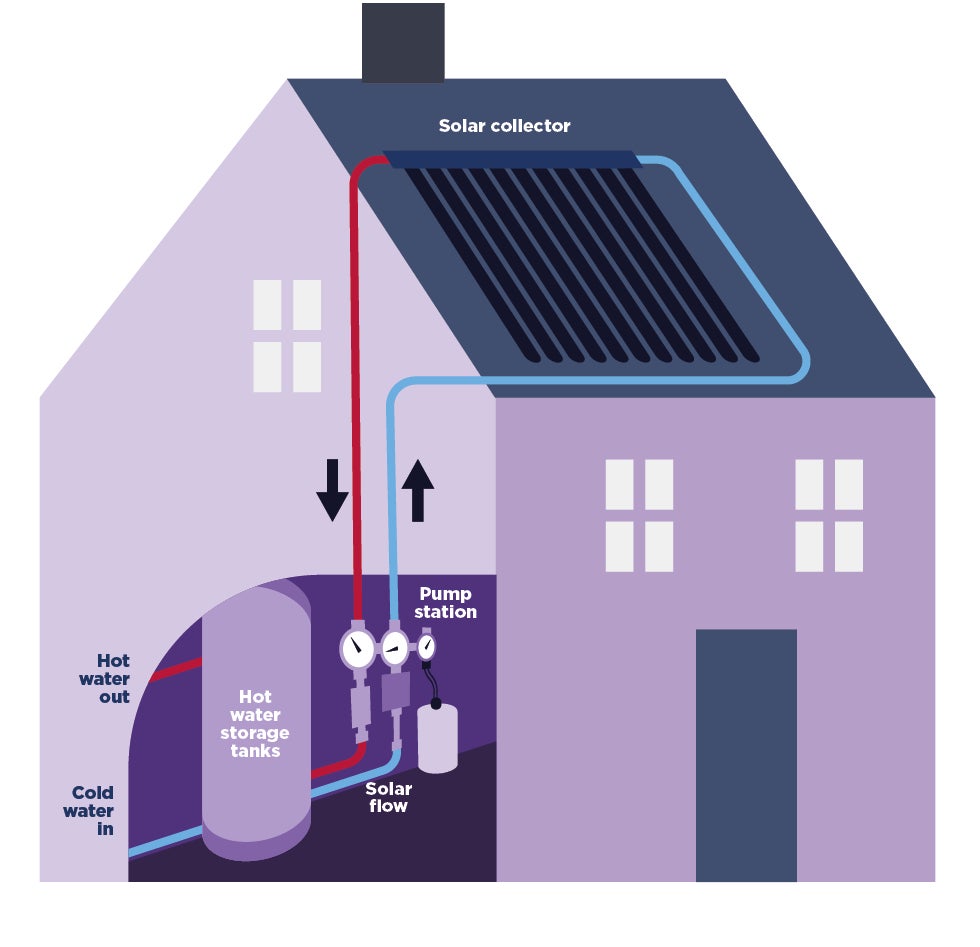
The dedicated solar hot water heating system can be a single tank (as illustrated above) or a dedicated solar tank can provide pre-heated water to a main hot water tank.
What are the different types of solar panel technologies?
There are two main groups of energy technologies used to generate electricity from sunlight.
Concentrated Solar Power (CSP)
CSP technologies produce electricity by focusing sunlight to produce heat and drive an engine connected to a generator. They’re usually found in countries with year-round sunshine, so are less common in Ireland.
Solar Photovoltaics (Solar PV)
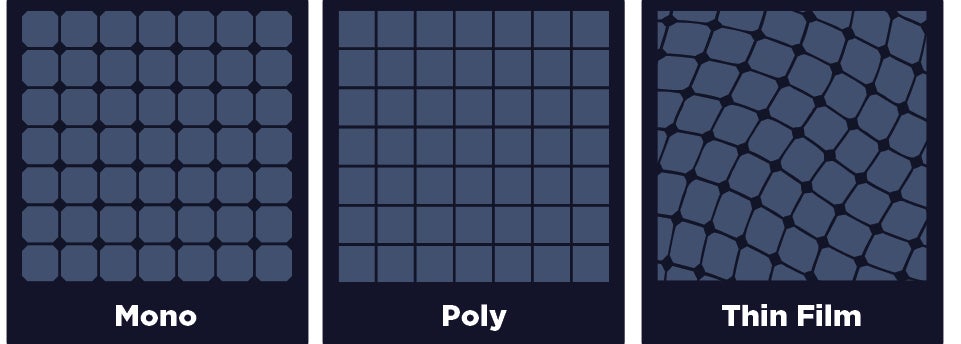
Ref: https://www.energysage.com/solar/101/types-solar-panels/
Given the constraints of CSP, solar PV panels are more popular in terms of demand, affordability and reliability for Irish homeowners and businesses.
There are three main types of solar PV panels most commonly found on the Irish market; thin-film PV panels, mono-crystalline, and polycrystalline PV panels.
Thin film solar panels are produced via the spraying of a thin layer of semiconductor material over another surface made of either glass, plastic, or metal. They are incredibly thin (around 20 times thinner than traditional c-Si semiconductor wafers) making them flexible and lightweight.
A thin film panel may last for over ten years, which is usually less than the average crystalline panel. However, with consistent technological advances improving the durability of thin films, they could soon reach a twenty-year lifespan.
More effective and efficient when compared to thin films and polycrystalline panels. Monocrystalline (MC) modules are made of a single silicon crystal. Being the most efficient and highest-quality panels, they’re also the most expensive.
Most of the crystalline panels available in the Irish market are made of mono-crystalline and are usually made from a large number of small crystals.
Many MC panels fitted also use a new technology called PERC Technology (Passive Emitter and Rear Cell) designed to capture reflected light at the rear of the panel to improve efficiency.
Peimar monocrystalline solar panels, produced using a combination of innovative production processes and advanced engineering techniques, provide maximum output and high performance. This allows fewer panels to be used to generate more energy, ideal if space is restricted or environmental conditions are challenging.
Modern design, using matching black cells, backsheet and frames with a long lifespan make this panel option increasingly popular throughout Ireland.
The cells on polycrystalline PV panels are formulated by melting together several fragments of silicon rather than a single silicon crystal like in mono-crystalline panels. Poly-crystalline panels are less efficient and usually need to be larger to generate enough energy but they’re also a cheaper option.
Matt black panels are also very popular in Ireland with both customers and city planners due to their visually more attractive profile.
How long do solar panels last?
Solar panels usually last somewhere between 20-30 years. This does not mean that solar panels stop generating electricity after this timeframe, but rather it means that their efficiency will substantially reduce.
This time indicates that energy production will decrease on the basis of what the manufacturer considers to be the optimal average production.
Get a free solar quoteDo solar panels work on cloudy and rainy days?
Perhaps the most common question we get asked in relation to solar energy in Ireland! Thankfully, modern solar panels still work properly during cloudy, wet and rainy days.
Solar panels are naturally most efficient on sunny days because of the direct sunlight being harnessed. However, even during bad weather conditions, solar panels will still generate power as solar cells are usually powered by light and not heat.
US-backed research has shown that high heat may actually cause solar panels to work less efficiently. Nevertheless, today’s technology requires rigorous testing of solar panels to ensure high efficiency and effectiveness.
For solar panels to be certified for installation on an Irish home, they’re subjected to rigorous reliability tests which include; dump heat tests, thermal cycling, and humidity freeze, among others.
What are the advantages of using solar power?
This means that solar energy can be harnessed in all areas of the world, unlike some other sources like fossil fuels.
Meeting your energy needs with your own installed solar energy system will cut your energy bills. The amount saved by the system depends on its size and the energy demands of your home; the current recommendation from the SEAI is that a solar system should be sized to cover a maximum of 70% of annual electricity usage.
Our solar installers will produce a report for your home using bespoke software that uses your location to determine the potential output of your system. Determining factors include, location, system size and roof orientation; south-facing is best but east-west orientation also works very well.
When your system is connected to the national grid and you generate more electricity than you require, the extra energy is sent back to the grid. If you’re signed up to our Microgen Export plan you’ll be paid for this in the form of credit on your bill.
If your system generates less energy than is required, the grid can also use the extra energy sent there to meet the deficit.
Solar energy systems have no moving parts like wind turbines, which means that wear and tear are eliminated. The inverter and the batteries are the only components that may require to be changed in about 5-10 years.
The lower maintenance cost of solar panels means lower system costs, and more savings for you in the long run.
What are the disadvantages of solar energy installation?
Like anything with a list of pros, there are also some cons to consider when deciding if solar is for you.
The initial cost of installing solar panels is substantial
The cost includes paying for solar panels, an inverter, batteries, system wiring, and the installation fee. However, as with all new technologies, prices will continue to reduce over time. There are also government grants available to make the initial costs more manageable.
Solar panels may not generate enough energy during prolonged spells of poor weather
While solar panels do generate energy during cloudy and rainy days, they may not be enough to meet your home’s energy requirements.
Of course, any power deficit can be comfortably met with battery-stored energy or from the excess energy sent to the energy grid.
Naturally, solar panels work best during summer months, with less solar energy produced during winter months. The main reason for this is how long the sun shines (as much as 18 hours a day in summer and as little as 8 in winter months) and how high the sun is in the sky (again, much lower during winter).
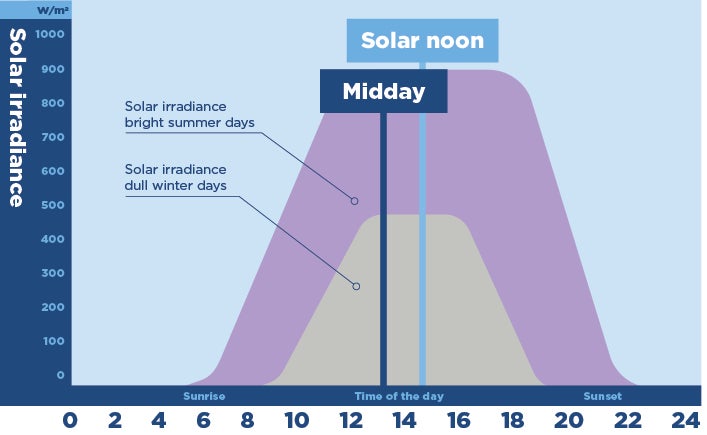
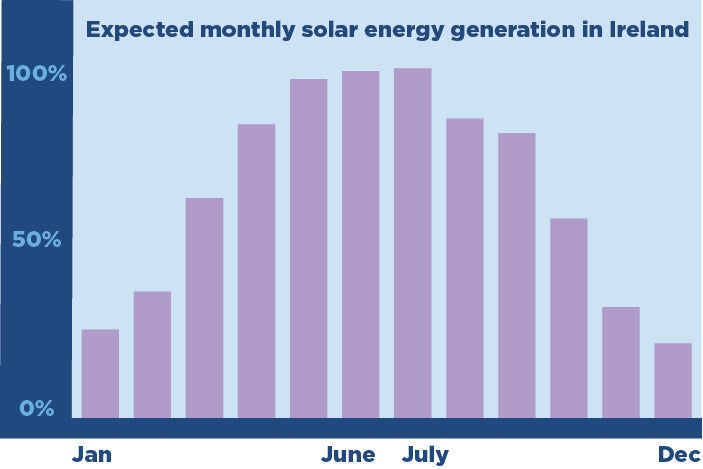
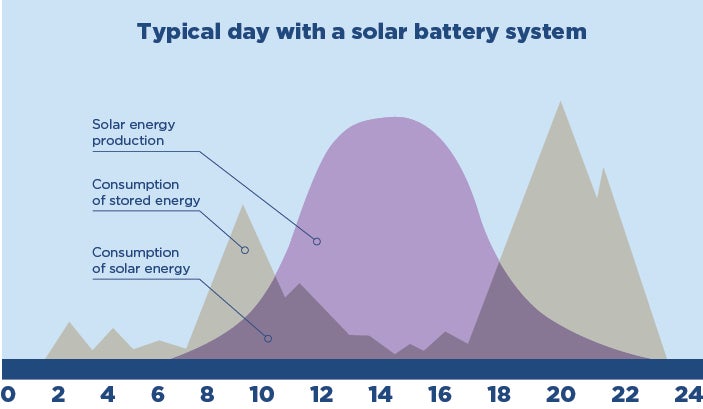
Solar panels may require a large space for installation
The more energy you need to produce, the more solar panels will be required. This means that a standard house roof may not be enough to install all the solar panels required.
However, our installers will always assess your home or business before installation takes place and will advise you on the best solution for your home.
Are there any government incentives for solar energy in Ireland?
The government see solar energy as a long-term method of broadening the sustainable energy mix in Ireland so have several incentives in place to help Irish consumers switch to solar energy.
The SEAI solar electricity grant is most relevant if you’re considering getting a solar PV system installed with us.
SEAI solar electricity grant
This grant can help you with the costs of installing solar PV panels in your home to generate renewable electricity.
Grant nameGrant name | ValueValue | ExampleExample | No. of panels (approx)No. of panels (approx) |
Grant nameSolar PV grant | Value€650 per kWp up to 2kWp | Example€1,300* for 2kWp solar panels | No. of panels (approx)5 panels |
Grant name | Value€250 for every additional kWp up to 4kWp | Example€1,550* for 3kWp solar panels | No. of panels (approx)7 panels |
Grant name | ValueTotal Solar PV grant capped at €1,800 | Example€1,800 for 4kWp solar panels | No. of panels (approx)10 panels |
*This figure is estimated pending the official grant values for 2025 from the SEAI.
How can I apply for a grant?
Who can apply
All homeowners, including private landlords, whose homes were built and occupied before 2021 can apply.
This is defined as the date your electricity meter was installed and is different to other grant measures where the home must be built before 2011.
Before you apply
Before you invest in solar PV, familiarise yourself with the contents of the Solar PV Scheme Application Guide which includes the Terms and Conditions of the scheme.
More information can be found on the SEAI website.
How to apply
- Get quotes and choose the company you wish to install your solar PV system.
- Agree a formal contract with them to get the works done.
- Apply for your grant and wait for your grant offer before you start the works.
- Don’t start works until you receive the grant offer.
- Grant offers are valid for eight months.
- Please note the grant, once approved, is only payable in respect of the measure, size of installation and grant amount referenced in the Grant Offer.
- Should you wish to increase the size of your array, you will need to contact the Solar PV Team in advance of works commencing, including up to the day of the installation, but before works start.
- Bord Gáis Energy will apply to ESB Networks to connect your solar PV system to the electricity network before installing it.
- This application process takes at least 4 weeks or 20 working days.
Your solar PV system can now be installed.
- Before your grant can be processed, you’ll need to get a post-installation BER assessment done by a registered BER assessor.
- Many homeowners forget this step: try to get your BER arranged immediately after your solar PV has been installed to speed up your grant payment.
We’ll give you the documentation related to your installation and submit copies to SEAI electronically.
Applications for payment can only be processed once all documentation has been uploaded and the BER cert is complete and published by your BER assessor.
After that is done, please allow 4 to 6 weeks for payment, with additional time if an inspection is required.
How much will it cost for a solar energy system in my home?
The cost of solar panels and the respective solar energy system you opt for is dependent on the amount of power you need for your home or business.
In all cases, our solar installer will need to visit your home or business to determine whether your roof or selected area offers enough space and is structurally fit for solar panel installation.
Then they’ll determine how many solar panels will be required based on your energy requirements.
Around €6,500 is the minimum you can expect to pay for one of our solar PV systems but the solar expert who performs your property survey will be able to advise based on your specific circumstances.
There are grants available through the SEAI to help offset the cost (subject to meeting eligibility requirements). See the SEAI solar grant eligibility requirements as a guide.
Solar PV installation for homes
Register your interest with us and we'll be in touch to organise a free solar survey.
Get a free quoteMicrogeneration
Find out how you can export surplus solar energy to the national grid through our Microgen Export Plan.
SEAI grants
Learn more about what grants are available from the Sustainability Energy Authority of Ireland when it comes to upgrading your home.
Solar for farms
We've partnered with the Irish Farmer’s Association (IFA) to offer rooftop solar solutions to Irish farmers.